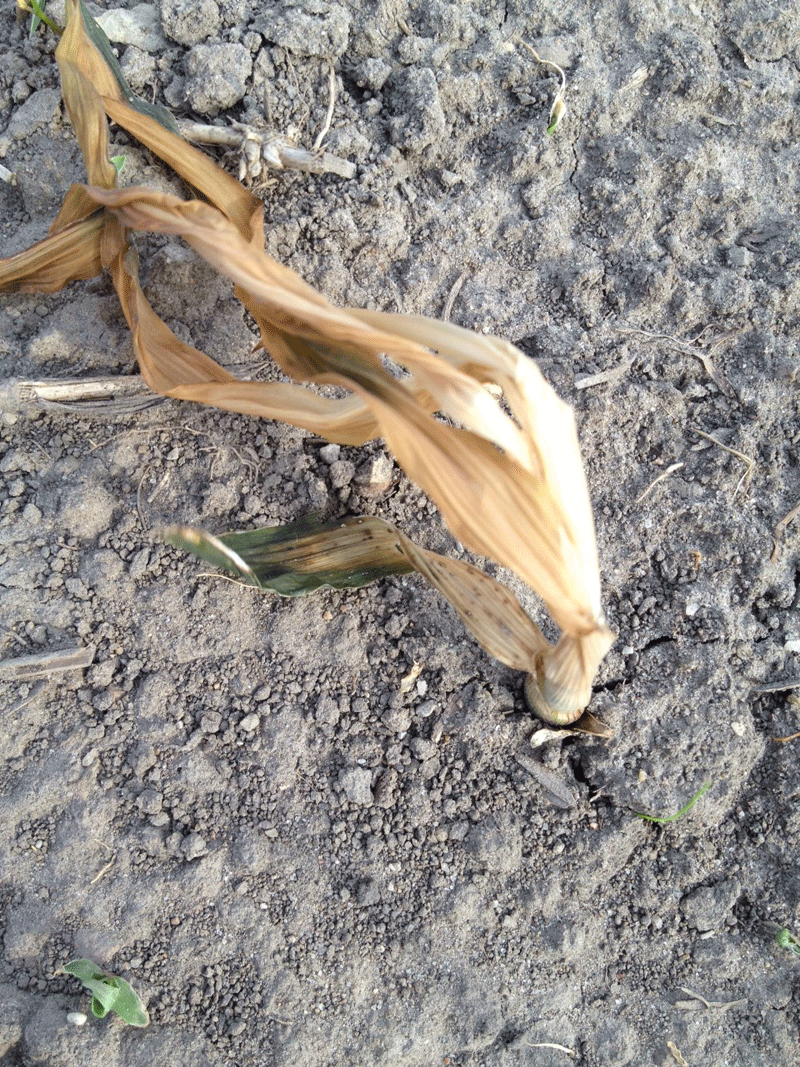Frosted corn and soybeans
CROP LOSS AND RECOVERY
SPRING 2015 STARTED off well with little rain and warm temperatures that allowed farmers to get seeds into the ground relatively early and many crops grew quickly. However, this soon changed when temperatures dipped to a deadly -3°C. There were two cool evenings in May when frost formed across Ontario. One frost occurred May 13 and the second hit just over a week later on May 22. The latter was the more damaging event — frosted corn and soybeans were discovered along with wheat, alfalfa, vegetable, and fruit crops from eastern to western Ontario.

For some farmers, the decision to replant was easy. For others with variable frosting and variable emergence throughout their fields, it was a gamble to see if the crop would recover in the upcoming weeks.
ASSESSING THE DAMAGE
Corn that was not replanted seemed to begin re-growing within three days of the frost event, with new growth pushing past the frosted off leaves. However, on low organic/sandier soils, plants that looked like they might survive the frost ended up dying off and there were some general trends seen in those corn fields where plants did not survive.
“The ultra-dry conditions were the huge factor in making a reasonable simple frost recovery exercise so difficult,” notes Ken Currah, market development agronomist with Pride Seeds. “Corn that was at the five leaf stage or younger, that was planted at a proper seed depth, should have recovered from frost injury because the growing point was protected. But, with the extremely dry conditions there was no moisture in the ground to seal off the soil, therefore, the cold temperatures got right in there and wreaked havoc on the plant physiology.”
This is why where the planter and/or sprayer tracks crossed over corn rows, the plants endured the frost better. There was improved seed to soil contact and the temperature of the soil was higher than areas around it.
Currah also adds that a major hot topic problem this spring was corn residue. “Last year’s corn stalks were still very well preserved and tough due to the cold winter. This caused issues when planting into them — many corn and soybean plants were placed at very shallow depths which made the seed more prone to lethal frost injury.”
According to Aaron Breimer, sales agronomist with Veritas Farm Management, similar correlations were seen in soybean fields that were killed by frost. At first, Breimer says it appeared that damage was completely random; but upon closer observation, areas with higher residue resulted in a greater chance of the plants being killed by frost. The residue had limited the amount of heat absorbed by the soil and then, during the frost event, acted as an insulator and kept what little heat was in the ground from being released and protecting the young plants. Because of this, Breimer notes that no-till soybeans were more affected than conventionally tilled soybeans, with some exceptions due to soil type.
RECOVERY
By the middle of June, corn fields were coming along and, in some areas, were approximately knee high. Frost affected plants were certainly shorter and poorer looking, but according to Peter Johnson, agronomist with RealAgriculture.com, they were not as far behind as we presume. Although some plants might not look like anything to boast about, it doesn’t mean the crop won’t yield. According to advice provided by Johnson via Wheat Pete’s Word, it all comes down to when the plants tassel. If the short plants tassel at the same time, or close to the same time, as the non-frost affected plants in the same field, then there is still potential for a good yield. Johnson does mention though, that previous studies have shown that 10% less yield potential might be seen on a frosted field — depending on how much of the field was affected.
For soybeans that were touched by frost, it is difficult to determine the expected yield loss on fields that were not replanted. Breimer says many of the fields affected had the main growing point killed, but the auxiliary growing points were not affected. This caused many plants to produce two pod bearing branches where they would usually only have one. Some fields that had areas completely killed off, and were not replanted, will have lower than usual yields due to the lower plant population.
Once all of the damage assessments had been made by the end of June, the total number of frost damaged acres reported to Agricorp was 142,944 acres. According to Michael Smyth, senior industry specialist at Agricorp, 60,251 of those acres were corn and 69,614 acres were soybeans. More than 33,000 acres had been claimed as re-seeded, although this number could still go up as paperwork was still being processed at press time. Smyth reminds farmers that any claims made are paid after they have reported their final acres and paid their premium. Only once the premium has been paid will Agricorp release the claim cheque. •







